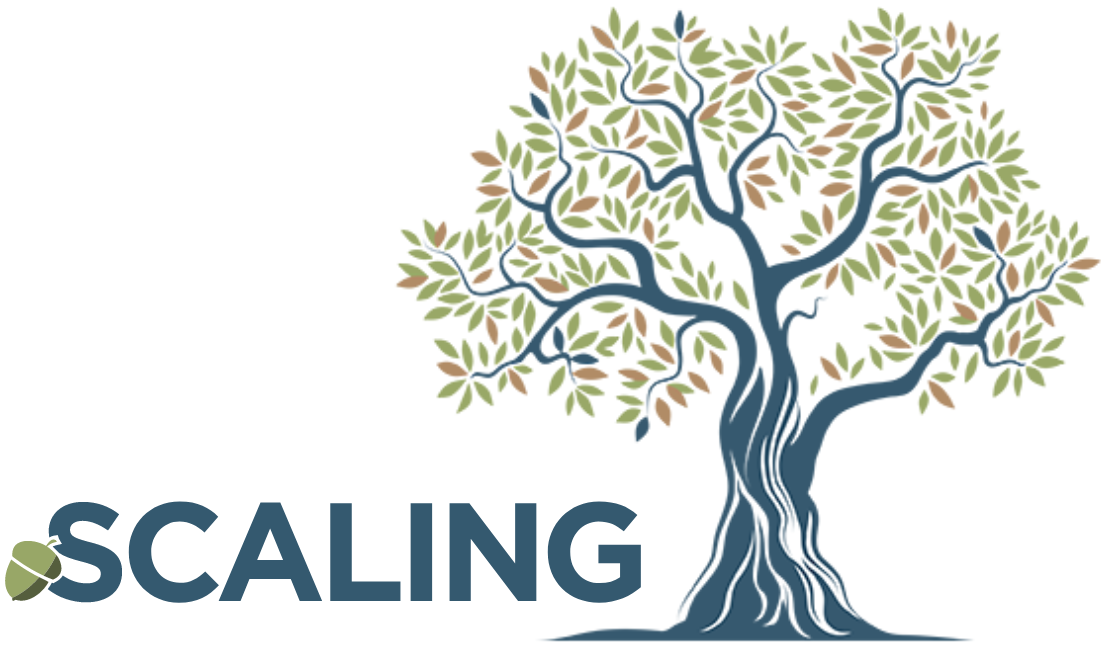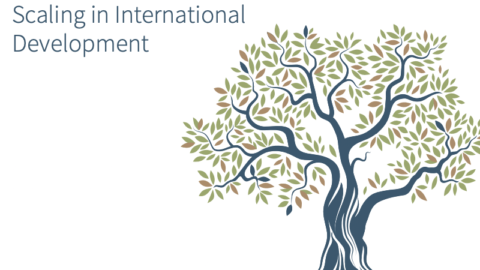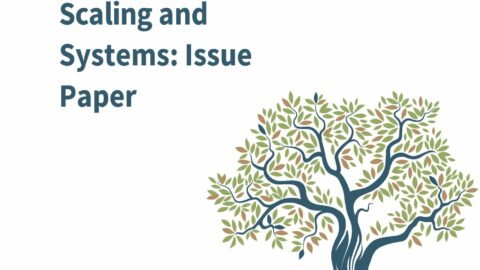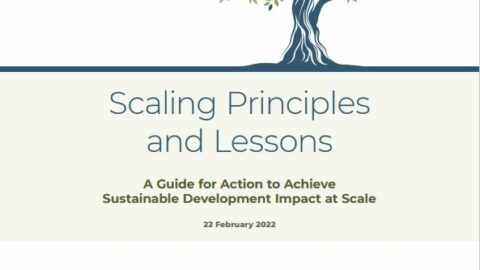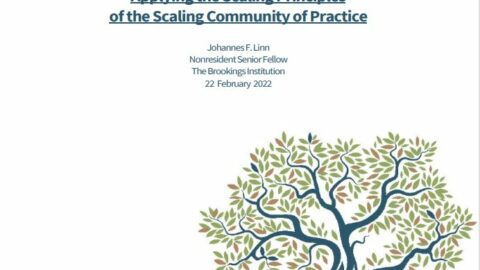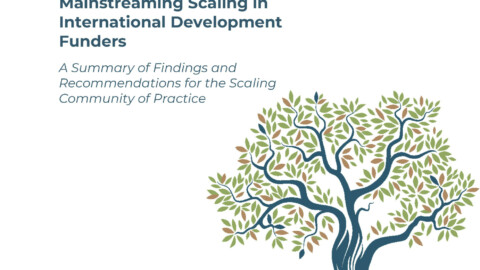Preface
The Scaling Community of Practice (CoP) launched an action research initiative on mainstreaming scaling in funder organizations in January 2023. This initiative has three purposes: to inform the CoP members and the wider development community of the current state of support for and operationalization of scaling in a broad range of development funding agencies; to draw lessons for future efforts to mainstream the scaling agenda in the development funding community; and to promote more effective funder support for scaling by stakeholders in developing countries. (For further details about the Mainstreaming Initiative, see the Concept Note on the COP website).
For the purpose of this initiative, scale is defined as sustainable impact at a significant share of the need, demand, or problem. Scaling is the process of reaching scale. Mainstreaming of scaling is defined as the systematic consideration by the funder of the scaling process in the appraisal of a project, in the decision to fund it, and in the monitoring and evaluation of the project’s implementation.
The Mainstreaming Initiative is jointly supported by Agence Française de Développement (AFD) and the Scaling Community of Practice (CoP). The study team consists of Richard Kohl (Lead Consultant and Project Co-Leader), Johannes Linn (Co-Chair of the Scaling CoP and Project Co-Leader), Larry Cooley (Co-Chair of the Scaling CoP), and Ezgi Yilmaz (Junior Consultant). MSI staff provide administrative and communications support, in particular Leah Sly and Gaby Montalvo.
The principal component of this research is a set of case studies of the efforts to mainstream scaling by selected funder organizations. These studies explore the extent and manner in which scaling has been mainstreamed, and the major drivers and obstacles. The case studies also aim to derive lessons to be learned from each donor’s experience, and, where they exist, their plans and/or recommendations for further strengthening the scaling focus.
The present case study focuses on successes, challenges and lessons in Feed the Future, The US Government’s Global Hunger and Food Security Initiative. It was prepared by Julie Howard, Independent Consultant, who served as Chief Scientist, Bureau for Food Security, and Senior Adviser to the USAID Administrator for Agricultural Research, Extension, and Education from 2011 to 2014.
Executive Summary
This paper presents a study of efforts to mainstream scaling within the CGIAR. The CGIAR is a network of research centers, partnerships and cross-center Initiatives that conduct research on agrifood systems to produce global public goods—research and innovations. These goods are targeted to improve productivity, income, food security, health and nutrition, and other goals in the Global South, particularly for small farmers and other marginalized populations. It is currently undergoing a fifteen-year long reform process that has led to greater integration of what were previously a largely independent and autonomous set of research centers. An important component of that process has been to mainstream scaling, particularly by ensuring that innovations are “scaling ready,” developing scaling strategies, supporting their implementation, and tracking progress towards impact at scale. These efforts provide an excellent opportunity for a case study of mainstreaming.
The CGIAR is mostly not a donor or development funder unlike many of the organizations being studied as part of the Scaling Community of Practice’s (COP) Mainstreaming Scaling Initiative (MSI). The CGIAR is primarily a research organization funded by the contributions of international donors. Nonetheless, there are several reasons to include it in the MSI. First, it is one of the largest sources of innovation in the international agricultural development space with a roughly $800 million annual budget and presence in nearly one hundred countries. Second, it has made significant efforts and progress in mainstreaming the scaling of innovations over the past decade. As innovation has become a major focus of international development in the last twenty years, we believe the CGIAR mainstreaming journey will be of great interest to other innovators and funders of innovation.
The origins of the CGIAR Centers and system are in the Green Revolution, often lauded as one of the great cases of successful scaling up in international development. As such, in one sense, one could say that scaling is in the system’s DNA. On the other hand, while many CGIAR innovations have gone to scale, until recently scaling was not a major focus for either CGIAR Centers or individual researchers. The assumption was that improved technology would scale organically by sharing genetic materials, varieties, and breeds with national actors, principally the institutions of national agricultural research and extension systems (NARES). Historically, partnerships with private seed companies were relatively limited.
Things changed considerably after the 2007-2008 food crisis which led to increased funding for agri-food research. The greater global attention and increased funding for research was accompanied by pressure from donors for CGIAR administrative reforms, including demands for increased accountability and greater impact at scale. The ensuing reform process culminated ten years later in agreement to create a much more centralized system, the so-called One CGIAR. That reform process, and the One CGIAR in particular, both explicitly included mainstreaming of scaling as well as reforms that were supportive of or facilitated scaling. Thus, the major drivers of mainstreaming were donor pressure and CGIAR leadership’s response to that pressure. Bottom-up innovation and support for scaling from researchers interested in scaling and system change frameworks and tools played a critical complementary role.
As a result of mainstreaming, scaling has been integrated into the CGIAR’s mission and vision. Scaling strategies are being developed for the 32 Initiatives under which centrally funded CGIAR investment is now organized. An in-depth scaling framework and toolkit has been developed, tested, and refined. Originally called Scaling Readiness, and now the Innovation Packages and Scaling Readiness (IPSR), the framework and tools focus on getting innovations scaling ready, identifying, and mobilizing scaling partnerships and tracking scaling progress. As with most innovating organizations, actual scaling is left to implementing partners at the regional, national, and local levels. The CGIAR is now in the early stages of rolling out IPSR throughout the organization with the goal of having more innovations ready for scaling and to support portfolio monitoring and management (PMM). This dual-use aspect of IPSR, scaling and portfolio management, was critical to its being mainstreamed.
Mainstreaming scaling is still largely limited to those activities covered by the central Initiatives (as well as the Initiatives themselves) i.e., the centralized or pooled portion of the CGIAR budget. This is currently around 31 percent of the total annual budget. Mainstreaming of IPSR only began a couple of years ago and is occurring within the environment of major organization-wide reform, which has been both challenging and supportive. While the number of innovations to which scaling readiness have been applied and/or included in PMM are small, they are growing rapidly. The internal target is that by end of 2024, ninety percent of CGIAR Initiative innovations will be reported under the IPSR PMM approach. The approach has already begun to scale to bilateral projects implemented under CGIAR Centers, as well as by partner funders.
Institutionalization and internal rollout of IPSR and scaling has advanced in some areas more than others. Substantial efforts have been made to build awareness, encourage utilization, and provide training. These have been accompanied by allocations of human, financial, and institutional resources to support scaling, including identifying a unit responsible – the Portfolio Performance Unit (PU). At the same time, changes in internal incentives and organizational culture to support scaling are in their early days. It is unclear whether the necessary investments will be made to support the use of IPSR as utilization grows.
Whether or not the CGIAR approach to mainstreaming scaling will be successful remains to be seen and will serve as an interesting experiment in mainstreaming scaling organizational change in general. Factors favoring success are: (a) pressure from donors for impact at scale will continue as 2030 and the deadline for the Sustainable Development Goals (SDGs) approaches; and (b) the obvious advantages of a portfolio management approach for accountability. The principal challenges are whether: (i) needed resources will materialize as uptake grows; (ii) the necessary changes in internal practice, culture and incentives can be realized; and (iii) the almost complete reliance on partners to do the actual scaling will deliver impact. The current approach also has several weaknesses, among them being largely supply driven and top down, and relying too heavily on data from national sources to track progress once scaling has been handed off to partners.
To address these and other issues, the paper has several recommendations. First, as the application of IPSR to individual innovations (and finding the supporting resources) is still in its early days, more vocal and visible leadership and support for this from senior management would help. Second, there is a bit of a “build the airplane as you’re flying it” approach to the rollout of IPSR and PMM. While this is no doubt largely a result of the pressurized reform environment of the last couple of years, it would be helpful to take a step back and develop a written, multi-year strategy with measurable milestones for the rollout and utilization of IPSR and PMM.
Third, the CGIAR should look for areas to achieve economies of scale and scope in the administration and application of IPSR, including putting some functions in a central unit. Centralized production of country analyses of context and stakeholders could serve as a basis for individual efforts, and one wonders whether identifying and developing relationships with partners might also benefit from higher-level relationship management and coordination.
Fourth, investment and greater attention are needed to increasing grassroots participation in applying IPSR and in primary data collection relevant to scaling progress in-country. Historically, those sources have been highly variable in terms of reliability and validity. Greater investment into its own data collection and increased quality assurance and technical support for in-country sources it relies upon is needed. Given the CGIAR’s strong capacity in cutting-edge genetics, one example of this would be to invest in selective sampling and tracking of diffusion through DNA fingerprint analysis in farmers’ fields.
Finally, while it appears that in these early days of rolling out IPSR adequate financial resources have been committed, there is yet no commitment of the kind of resources that will be needed to implement ISPR institution wide as well as support scaling more generally. Even the scaling through partnerships that the CGIAR envisages takes significant financial and human resources, not the least of which are to create, manage and support those partnerships with scaling implementers. There is a risk that in an organization whose primary purpose is research and innovation and where resources are scarce, the resources needed will be underestimated and a low priority. This risk is reinforced by an implicit assumption that the necessary scaling partners exist and have the capacity and resources of their own to take CGIAR innovations to scale. Resource mobilization for scaling by both CGIAR and its partners needs to be a priority. Otherwise, the potential impact at scale contained in CGIAR research and innovations will not be realized.
The CGIAR case yields some important lessons for mainstreaming. First, the fact that the IPSR tool was developed internally and organically by staff has probably facilitated its adoption and increases the chances of successful mainstreaming. While donor pressure and management response to that pressure was the key driver, having this internal framework available helped advance mainstreaming more rapidly. While Monitoring, Evaluation, Accountability and Learning was not a major initial driver, it is likely to play a key role in sustaining operationalization of IPSR and PMM.
Second, using a scientific and applied research approach to designing their scaling framework gave it credibility in what is essentially a scientific organizational culture. It also resulted in a more substantive scaling framework than is common among large international organizations and is largely aligned with best practices in scaling. Third, centralized funding seems to have been a significant facilitator of mainstreaming, especially when combined with the fact that CGIAR funding decisions are annual. Unlike the multi-year replenishments of other international organizations, this funding mechanism facilitates quick feedback on progress and accountability to donors for mainstreaming scaling. (It unfortunately also adversely affects the stability of funding and long-term planning and investment decisions).
Perhaps most important for mainstreaming was the fact that IPSR can be, and is being, used both for scaling readiness AND to conduct portfolio management. This dual-purpose function allowed management to address donors’ twin demands for accountability and impact at scale with one tool. Portfolio monitoring has enormous potential as it evolves to include portfolio management, and hopefully eventually to inform investment decisions regarding research and innovations as they move through the various stages of development and scaling.
Future progress in mainstreaming will be heavily influenced by what happens to the reform and centralization process, and to One CGIAR in particular. One CGIAR has received substantial pushback internally and from some Centers and its ultimate structure and implementation are uncertain. Centralization is probably more favorable to progress in mainstreaming, especially if accompanied by an increase in the share of pooled funding. However this turns out, these multiple and ambitious efforts and commitments provide important lessons and insights for other international development organizations, especially those involved in research and innovation.
